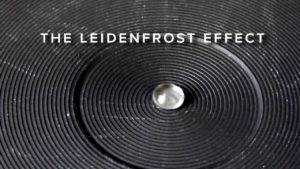Table of Contents
Dipping hand into liquid nitrogen
In the mesmerizing video above, a scientific phenomenon takes center stage—The Leidenfrost Effect. What unfolds is not just a captivating spectacle but a delicate interplay of physics, where the formation of an insulating gas barrier orchestrates a graceful dance between liquid nitrogen and a “relatively hot” hand.
The Leidenfrost Ballet:
- Hand and Liquid Nitrogen Encounter:
- As the hand meets the frigid embrace of liquid nitrogen, magic ensues. The secret lies in the formation of an insulating gas barrier, a protective shield that emerges between the hand and the extremely cold liquid. This barrier acts as a thermal mediator, significantly slowing down the transfer of heat from the hand to the liquid nitrogen.
- Gas Barrier Dynamics:
- The insulating gas barrier, primarily composed of vaporized nitrogen, becomes the unsung hero, allowing the hand to plunge into the liquid nitrogen without causing harm. By reducing the direct contact and heat exchange, this ephemeral shield becomes the guardian of the hand, enabling it to emerge unscathed from the frosty encounter.
Frying Pan Drama:
- Water Droplets Take the Stage:
- Shifting the spotlight to a hot frying pan, droplets of water make their entrance. The moment these water droplets make contact with the sizzling surface, a transformation occurs. The lower section of the droplets instantaneously vaporizes upon contact, giving rise to a swift insulating gas layer.
- Gas Layer as a Protector:
- This newfound gas layer, akin to the one witnessed in the liquid nitrogen escapade, becomes a protective cushion. It slows down the transfer of heat from the pan to the water droplets, creating a mesmerizing visual—water droplets seemingly defying gravity as they delicately hover atop the air layer.
The Science Behind the Spectacle:
- Temperature Dynamics:
- The Leidenfrost Effect hinges on the temperature differential. The surface temperature of the hand or the water droplets is not high enough to instantaneously vaporize the contacting liquid (liquid nitrogen or water). Instead, a vapor layer forms, acting as a shield against rapid heat exchange.
- Insulating Gas Barrier:
- The insulating gas barrier, predominantly composed of vaporized nitrogen or water vapor, serves as an intermediary layer. It curtails direct contact between the relatively hot surface and the frigid liquid, preventing immediate freezing or scalding.
Practical Applications:
- Cooking Magic:
- The Leidenfrost Effect isn’t confined to captivating experiments; it finds practical use in the culinary realm. Skilled chefs leverage this phenomenon when cooking by flicking droplets of water onto a hot griddle. The resulting dance of water droplets showcases the protective gas layer at play.
- Industrial Insights:
- Understanding the Leidenfrost Effect is not merely about entertainment. In industries involving rapid cooling or heating processes, this phenomenon provides insights into optimizing efficiency and safety by managing heat transfer dynamics.
Conclusion:
The Leidenfrost Effect, witnessed in the graceful interplay between liquid nitrogen, a “relatively hot” hand, and water droplets on a sizzling frying pan, is a testament to the captivating beauty of physics in action. Beyond its visual allure, this phenomenon unveils a world where insulating gas barriers become the unsung heroes, safeguarding against the extremes of temperature.
In the delicate dance between heat and gas, science takes center stage, offering both spectacle and understanding. The Leidenfrost Effect, a symphony of temperature differentials and vaporized shields, invites us to explore the realms where physics transforms everyday encounters into moments of wonder and insight.
Another version of the Leidenfrost Effect:
